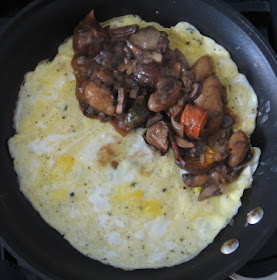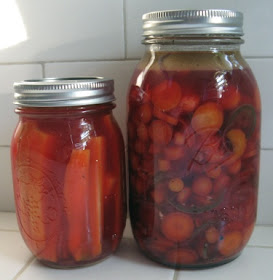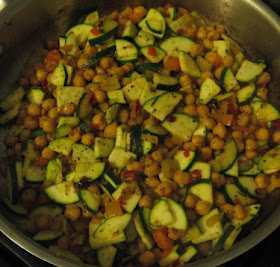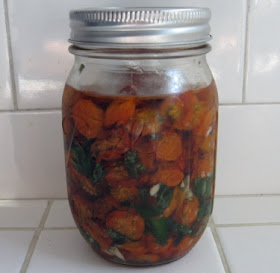


It was an excellent night.
We made:
- Veganomicon cassoulet with
olive oil biscuits-
Lentils vinaigrette- A big green salad with backyard sungold tomatoes
- Mashed potatoes and
mushroom gravy- Roasted mixed root vegetables in
vinaigrette- Garlic dills and
spicy carrot pickles- Maple-roasted cashews
Chrissy and Ben made:
- Tofurky
- Roasted pecan, olive, and grape salad
- Pumpkin pie
There was also plenty of wine.

Notes:
- I made the vinaigrette dressing (for both salad and roasty veg), the croutons, and the lentils the night before. This worked admirably. The
vinaigrette recipe makes over a pint, so you should expect to see it around over the next few months.
- I did not like the cassoulet! It was just kind of stodgy and tasteless. We had added seared marinated tempeh to it, but I kept the spices mild to match the cassoulet recipe. Yeah, no. It would have been a much better idea to just do our customary super-spicy marinade, with maybe some liquid smoke added, and then to sear it separately and strew bits liberally over the top of each serving bacon-style.
- The
biscuits, which I made with rice milk, were good. We ate the leftovers for breakfast in the morning.
- For the potato seasoning, we poached a bunch of minced shallot and garlic in olive oil and mashed them in. With some rice milk, salt, and pepper, this made the best mashed potatoes ever. Who says you need butter for mashed potatoes? You do not.
- Similarly, the
mushroom gravy was really, really good. It was so much better than last year's version, which did not contain either 1. enough mushrooms or 2. nutritional yeast. This year's version contained plenty of cremini mushrooms and the required nutritional yeast, and it was fabulous on both potatoes and tofurky.
- I really like tofurky! I don't think I'd ever had it before. It was particularly excellent mixed up in a big bite with potatoes and gravy, as all thanksgiving main courses should be.
- So I made garlic croutons, then forgot to put them on the salad! SO SAD.
 Garlic croutons
Garlic croutonsgood stale bread
olive oil
garlic
Smash and peel a couple of cloves of garlic and steep them in maybe 1/4 cup of olive oil for twenty minutes. In the meantime, get out the loaf of stale bread that's been hiding on top of the refrigerator. Cut it into reasonable crouton pieces. Toss the croutons with the oil, turning well to coat. You can pick the garlic cloves out or leave them in; I left mine in. Then spread the croutons on a baking sheet and bake at 350F until golden brown, paying attention to make sure they don't burn. This took about ten minutes for me, but it'll depend on your bread quality and piece size. Salt the croutons right after you take them out of the oven. Voila! Now you can put them in a container, put it in the cupboard, and forget all about it until after dinner is over.
- The roasted veg were a bit overdone, but still good. This year we had radishes, fingerling potatoes, onion, garlic, carrots, brussels sprouts, and golden beets. Was that it? I think that was it. We just tossed them with vinaigrette, salt, and pepper, added some fresh rosemary and thyme, and roasted at 350F until great.
-
Lentils vinaigrette are totally going to become staples in our house. OH MAN. I just ate the last of them today for lunch, and they were still perfectly textured and flavored. Granted, I did use the slightly more expensive (and sturdier, and better textured) Puy lentils instead of standard green, but they are well worth it. If I had to pack a lunch to work, I would definitely be spending a good number of Sundays making big batches of lentils vinaigrette to eat all week. I can just see them sitting in a corner of an excellent bento.
- Then there was pie. Pie pie pie pie pie pie pie. I think there is one piece left for me to eat tonight. Pie.
- Guess what I made out of the leftover mushroom gravy and roasted veg?
THANKSGIVING OMELET!

I warmed the gravy and root veg in a little saucepan, then made the omelet itself in a regular nonstick. I used two eggs and followed
the classic Julia Child omelet method (that is video, for those of you). When the eggs were 90% cooked, I poured in the gravy and veg, folded the omelet over, let it cook for another 30 seconds or so, and flipped it out of the pan.
With a handful of chopped parsley and forgotten garlic croutons strewn over the top, this omelet became perhaps the best leftover thanksgiving concoction ever.

 REALLY.
REALLY. Guess what? It was delicious.
Guess what? It was delicious. Of course, in the morning I dropped the leftovers into a plain pancake batter, fried them up, and ate them with pungent labneh and sambal. It's all good.
Of course, in the morning I dropped the leftovers into a plain pancake batter, fried them up, and ate them with pungent labneh and sambal. It's all good.

























